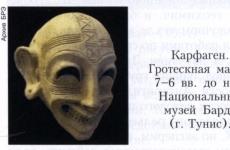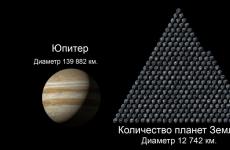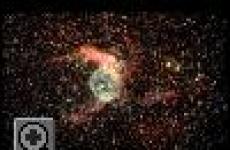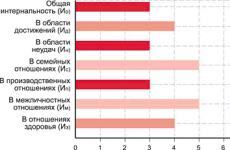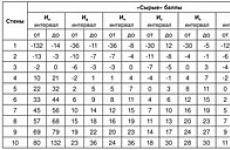The impressive scale of Jupiter. Description, interesting facts and sizes of Jupiter in comparison with other planets Comparative characteristics of the earth and Jupiter
The structure of the planet is multi-layered, but it is difficult to talk about specific parameters. There is only one possible model to consider. The atmosphere of the planet is considered to be a layer starting from the upper part of the cloud and extending to a depth of about 1000 kilometers. At the lower edge of the atmospheric layer, the pressure is up to 150 thousand atmospheres. The temperature of the planet at this boundary is about 2000 K.
Below this region is a gas-liquid layer of hydrogen. This layer is characterized by the transition of a gaseous substance into a liquid as it deepens. Science currently cannot describe this process in terms of physics. It is known that at temperatures exceeding 33 K, hydrogen exists only in the form of a gas. However, Jupiter completely destroys this axiom.
In the lower part of the hydrogen layer, the pressure is 700,000 atmospheres, while the temperature increases to 6500 K. Below is an ocean of liquid hydrogen without the slightest gas particles. Under this layer is ionized, decayed into hydrogen atoms. This is the reason for the strong magnetic field of the planet.
The mass of Jupiter is known, but it is difficult to speak definitely about the mass of its core. Scientists believe that it can be 5 or 15 times larger than the earth. It has a temperature of 25,000-30,000 degrees at a pressure of 70 million atmospheres.
Atmosphere
The red hue of some of the planet's clouds indicates that Jupiter includes not only hydrogen, but also complex compounds. The atmosphere of the planet contains methane, ammonia and even particles of water vapor. In addition, traces of ethane, phosphine, carbon monoxide, propane, acetylene were found. Of these substances, it is difficult to isolate one, which is the cause of the original color of the clouds. These are equally likely to be compounds of sulfur, organic substances or phosphorus.
Lighter and darker bands, located parallel to the equator of the planet, are multidirectional atmospheric currents. Their speed can reach up to 100 meters per second. The boundary of the currents is rich in huge turbulences. The most impressive of them is the Great Red Spot. This whirlwind has been raging for more than 300 years and has dimensions of 15x30 thousand km. The timing of the hurricane is unknown. It is believed to have been raging for thousands of years. A hurricane makes a complete revolution around its axis in a week. The atmosphere of Jupiter is rich in similar vortices, which, however, are much smaller and live no longer than two years.
Ring
Jupiter is a planet with a mass much larger than Earth's. In addition, it is full of surprises and unique phenomena. So, on it there are polar lights, radio noise, dust storms. The smallest particles that have received an electric charge from the solar wind have an interesting dynamics: being an average between micro- and macro-bodies, they almost equally react to electromagnetic and gravitational fields. These particles form the ring that surrounds the planet. It was opened in 1979. The radius of the main part is 129 thousand km. The width of the ring is only 30 km. In addition, its structure is very rarefied, so it can only reflect thousandths of a percent of the light that hits it. It is impossible to observe the ring from the Earth - it is so thin. In addition, it is constantly deployed with a thin edge towards our planet due to the slight inclination of the axis of rotation of the giant planet to the plane of the orbit.
A magnetic field
The mass and radius of Jupiter, coupled with its chemical composition, allow the planet to have a giant magnetic field. Its intensity greatly exceeds that of the earth. The magnetosphere extends far into space, for a distance of about 650 million km, even beyond the orbit of Saturn. However, towards the Sun, this distance is 40 times less. Thus, even at such vast distances, the Sun "does not give way" to its planets. This "behavior" of the magnetosphere makes it completely different from the sphere.
Will he become a star?
Strange as it may seem, it may still happen that Jupiter becomes a star. One of the scientists put forward such a hypothesis, coming to the conclusion that this giant has a source of nuclear energy.
At the same time, we know perfectly well that no planet, in principle, can have its own source. Even though they are visible in the sky, this is due to reflected sunlight. Whereas Jupiter radiates much more energy than the Sun brings to it.
Some scientists believe that in about 3 billion years, the mass of Jupiter will be equal to the sun. And then a global cataclysm will happen: the solar system in the form in which it is known today will cease to exist.
Jupiter is known to be the largest planet in the solar system. The size of this planet is truly impressive, it is definitely the record holder for the size of the planets of the solar system, but planets have been discovered that are even larger than our Jupiter. But the true size of Jupiter is difficult to determine exactly due to a number of reasons ...
Problems measuring the size of Jupiter.
The planet Jupiter is officially named the largest planet in the solar system, but despite this, no one knows the real size of this planet. The problem with measuring Jupiter's size lies in its thick atmosphere in which chemical reactions are constantly taking place. All we see when we look at Jupiter are its clouds, which people take for the real size of the planet, but the true size of Jupiter can be much smaller.
Thick clouds of the planet make it difficult to see its surface, because it is by the size of the surface of the planet that we determine the size of the planet itself. In the case of Jupiter, the dimensions of the surface are taken into account by the visible boundary of the clouds, so scientists can only start from examining various data obtained from probes in Jupiter's orbit.
Size of Jupiter and Earth

318 times the size of the planet Earth. The mass of Jupiter is very huge, it is huge enough that Jupiter can attract objects flying past it. Also, due to the mass of the planet, there are static ones. Cases have been repeatedly recorded of how Jupiter attracted and absorbed into its atmosphere various space objects heading towards the planets of the Earth group. If not for this “protector”, then much more meteorites and asteroids would reach the Earth and could threaten our lives. Because of its size, Jupiter has a ton of satellites in its orbits, including .
So the size of Jupiter may have saved our planet hundreds of times. If not for Jupiter, then life on Earth could have been destroyed long ago by a meteorite that hit our planet.
Planets larger than Jupiter.
Despite the fact that Jupiter is by far the largest planet in the solar system, there are planets that are much larger than Jupiter. These planets are in other star systems and some of them are closer to their star than Jupiter. Being closer to the star, other gas giants have a temperature much higher than Jupiter, which makes these planets huge. TRES-4 is the largest known planet 
If you look at the northwestern part of the sky after sunset (southwestern in the northern hemisphere), you will find one bright point of light that stands out easily from everything around it. This is the planet, shining with intense and even light.
Today, people can explore this gas giant like never before. After a journey of five years and decades of planning, NASA's Juno spacecraft has finally reached Jupiter's orbit.

Thus, humanity is witnessing the entry into a new phase of exploration of the largest of the gas giants in our solar system. But what do we know about Jupiter and with what base should we enter this new scientific milestone?
Size matters
Jupiter is not only one of the brightest objects in the night sky, but also the largest planet in the solar system. It is because of the size of Jupiter that it is so bright. What's more, the mass of the gas giant is more than twice that of all the other planets, moons, comets, and asteroids in our system combined.
Jupiter's sheer size suggests that it may have been the very first planet to form in orbit around the Sun. The planets are thought to have originated from the debris left after an interstellar cloud of gas and dust coalesced during the formation of the Sun. Early in its life, our then young star generated a wind that blew away most of the remaining interstellar cloud, but Jupiter was able to partially contain it.
Moreover, Jupiter contains a recipe for what the solar system itself is made of - its components correspond to the content of other planets and small bodies, and the processes that occur on the planet are fundamental examples of the synthesis of materials to form such amazing and diverse worlds as the planets of the solar system .
king of the planets

Given the excellent visibility, Jupiter, along with, and, people have observed in the night sky since ancient times. Regardless of culture and religion, humanity considered these objects unique. Even then, observers noted that they do not remain motionless within the patterns of constellations, like stars, but move according to certain laws and rules. Therefore, the ancient Greek astronomers ranked these planets among the so-called "wandering stars", and later the term "planet" itself appeared from this name.
It is remarkable how accurately the ancient civilizations designated Jupiter. Not knowing then yet that it is the largest and most massive of the planets, they named this planet in honor of the Roman king of the gods, who was also the god of the sky. In ancient Greek mythology, the analogue of Jupiter is Zeus, the supreme deity of Ancient Greece.
However, Jupiter is not the brightest of the planets, this record belongs to Venus. There are strong differences in the trajectories of Jupiter and Venus in the sky, and scientists have already explained why this is due. It turns out that Venus, being an inner planet, is located close to the Sun and appears as an evening star after sunset or a morning star before sunrise, while Jupiter, being an outer planet, is able to wander around the entire sky. It was this motion, along with the planet's high brightness, that helped ancient astronomers mark Jupiter as the King of the planets.

In 1610, from the end of January to the beginning of March, the astronomer Galileo Galilei observed Jupiter with his new telescope. He easily identified and tracked the first three, and then four bright points of light in his orbit. They formed a straight line on either side of Jupiter, but their positions constantly and steadily changed in relation to the planet.
In his work, which is called Sidereus Nuncius ("Interpretation of the Stars", lat. 1610), Galileo confidently and quite correctly explained the movement of objects in orbit around Jupiter. Later, it was his conclusions that became proof that all objects in the sky did not orbit, which led to a conflict between the astronomer and the Catholic Church.
So, Galileo managed to discover the four main satellites of Jupiter: Io, Europa, Ganymede and Callisto, satellites that scientists today call the Galilean moons of Jupiter. Decades later, astronomers were able to identify other satellites, the total number of which is currently 67, which is the largest number of satellites in the orbit of a planet in the solar system.
big red spot

Saturn has rings, Earth has blue oceans, and Jupiter has strikingly bright and swirling clouds formed by the gas giant's very rapid rotation on its axis (every 10 hours). Spot formations observed on its surface represent formations of dynamic weather conditions in Jupiter's clouds.
For scientists, the question remains how deep these clouds go to the surface of the planet. It is believed that the so-called Great Red Spot - a huge storm on Jupiter, discovered on its surface back in 1664, is constantly shrinking and decreasing in size. But even now, this massive storm system is roughly twice the size of Earth.
Recent observations by the Hubble Space Telescope indicate that starting in the 1930s, when the object was first observed sequentially, its size could have halved. Currently, many researchers say that the reduction in the size of the Great Red Spot is happening more and more rapidly.
radiation hazard

Jupiter has the strongest magnetic field of all the planets. At the poles of Jupiter, the magnetic field is 20,000 times stronger than on Earth, and it extends millions of kilometers into space, reaching the orbit of Saturn in the process.
The heart of Jupiter's magnetic field is considered to be a layer of liquid hydrogen hidden deep inside the planet. Hydrogen is under such high pressure that it becomes liquid. So given that the electrons inside the hydrogen atoms are able to move around, it takes on the characteristics of a metal and is able to conduct electricity. Given Jupiter's rapid rotation, such processes create an ideal environment for creating a powerful magnetic field.
Jupiter's magnetic field is a real trap for charged particles (electrons, protons and ions), some of which fall into it from solar winds, and others from Jupiter's Galilean satellites, in particular, from volcanic Io. Some of these particles are moving towards Jupiter's poles, creating spectacular auroras all around that are 100 times brighter than those on Earth. The other part of the particles, which is captured by Jupiter's magnetic field, forms its radiation belts, which are many times larger than any version of the Van Allen belts on Earth. Jupiter's magnetic field accelerates these particles to such an extent that they move in belts at almost the speed of light, creating the most dangerous zones of radiation in the solar system.
Weather on Jupiter

The weather on Jupiter, like everything else about the planet, is very majestic. Above the surface, storms rage all the time, which constantly change their shape, grow thousands of kilometers in just a few hours, and their winds twist clouds at a speed of 360 kilometers per hour. It is here that the so-called Great Red Spot is present, which is a storm that has been going on for several hundred Earth years.
Jupiter is wrapped in clouds of ammonia crystals that can be seen as bands of yellow, brown and white. Clouds tend to be located at specific latitudes, also known as tropical areas. These bands are formed by supplying air in different directions at different latitudes. The lighter shades of the areas where the atmosphere rises are called zones. The dark regions where air currents descend are called belts.
gif 
When these opposite currents interact with each other, storms and turbulence appear. The depth of the cloud layer is only 50 kilometers. It consists of at least two levels of clouds: lower, denser and upper, thinner. Some scientists believe that there is still a thin layer of water clouds under the ammonia layer. Lightning on Jupiter can be a thousand times more powerful than lightning on Earth, and there is almost no good weather on the planet.

Although most of us think of Saturn with its pronounced rings when we mention the rings around the planet, Jupiter also has them. Jupiter's rings are mostly dust, making them hard to see. The formation of these rings is believed to have been due to Jupiter's gravity, which captured material ejected from its moons as a result of their collisions with asteroids and comets.
Planet - record holder
To summarize, it is safe to say that Jupiter is the largest, most massive, fastest-rotating, and most dangerous planet in the solar system. It has the strongest magnetic field and the largest number of known satellites. In addition, it is believed that it was he who captured the untouched gas from the interstellar cloud that gave birth to our Sun.

The strong gravitational influence of this gas giant helped move material in our solar system, pulling ice, water and organic molecules from the outer cold regions of the solar system to its inner part, where these valuable materials could be captured by the Earth's gravitational field. This is also indicated by the fact that The first planets that astronomers discovered in the orbits of other stars almost always belonged to the class of the so-called hot Jupiters - exoplanets whose masses are similar to the mass of Jupiter, and the location of their stars in orbit is close enough, which causes a high surface temperature.
And now, when the Juno spacecraft already orbiting this majestic gas giant, the scientific world has the opportunity to unravel some of the mysteries of Jupiter's formation. Will the theory that did it all start with a rocky core, which then attracted a huge atmosphere, or is Jupiter's origin more like the formation of a star formed from a solar nebula? For these other questions, scientists plan to find answers during the next 18-month Juno mission. dedicated to a detailed study of the King of the planets.

The first recorded mention of Jupiter was by the ancient Babylonians in the 7th or 8th century BC. Jupiter is named after the king of the Roman gods and the god of the sky. The Greek equivalent is Zeus, the lord of lightning and thunder. Among the inhabitants of Mesopotamia, this deity was known as Marduk, the patron saint of the city of Babylon. The Germanic tribes referred to the planet as Donar, which was also known as Thor.
Galileo's discovery of the four satellites of Jupiter in 1610 was the first proof of the rotation of celestial bodies not only in the orbit of the Earth. This discovery was also additional proof of the Copernican heliocentric model of the solar system.
Of the eight planets in the solar system, Jupiter has the shortest day. The planet rotates at a very high speed and rotates around its axis every 9 hours and 55 minutes. Such a rapid rotation causes the effect of a flattening of the planet and that is why it sometimes looks oblate.
One orbit around the Sun at Jupiter takes 11.86 Earth years. This means that when viewed from Earth, the planet appears to be moving very slowly in the sky. Jupiter takes months to move from one constellation to another.
1. Jupiter has at least 79 moons, the largest of which are Io, Europa, Ganymede and Callisto. They were discovered by Galileo Galilei in 1610.
2. The equatorial radius of Jupiter is 71.4 thousand kilometers - this is 11.2 times larger than our Earth.

3. The mass of Jupiter is 317.8 times the mass, and 2.47 times the total mass of all other planets.
4. The distance between Jupiter and Earth varies from 588 to 967 million kilometers.
5. There are no seasons on Jupiter, since the planet's axis of rotation is almost perpendicular to its orbit.
6. Jupiter rotates around its axis faster than any other planet in the solar system - the period of rotation at the equator is 9 hours 50 minutes 30 seconds.
7. Wind speeds on Jupiter can exceed 600 kilometers per hour. Jupiter's winds are driven mainly by its internal heat, and not by the sun's as on Earth.

8. Of the greatest interest among the satellites of Jupiter is Europa. Its main feature is the presence of water - from above it is completely covered with a thick layer of ice. Studies have shown that the ocean extends 90 kilometers deep, and its volume exceeds that of the earth.
9. Jupiter radiates 60% more energy than it receives from. Due to the processes leading to the production of this energy, Jupiter decreases by about 2 centimeters per year.
10. Jupiter makes a complete revolution around the Sun in 11.86 years.
11. Jupiter is similar in composition to the Sun - 89% of its atmosphere is hydrogen and 11% helium.
12. At the center of hurricanes on Jupiter, astronomers observe colossal lightning flashes that stretch for thousands of kilometers. The power of such lightning is three times higher than that of the earth.

13. An interesting feature of Jupiter is the presence of the Great Red Spot. It is a giant hurricane with a size of 15 × 30 thousand kilometers, which is much larger than the size of the Earth. The red color of this spot has not yet found an unambiguous explanation. Perhaps this color is given by chemical compounds, including phosphorus.
14. Scientists believe that Jupiter has a solid core one and a half times the diameter of the Earth, but 10-30 times denser. Even if there were a solid surface on Jupiter, it would be impossible to stand on it without fear of being crushed by the weight above the underlying atmosphere.
15. The first spacecraft to orbit Jupiter was the Galileo. The device was launched in 1989, in 1995 it entered the orbit of Jupiter, having worked until 2003. During its work, Galileo transmitted 14 thousand images of the planet and satellites, as well as unique information about the atmosphere of Jupiter.
16. Saturn is not the only planet with rings. Jupiter has faint rings, but they are very thin and difficult to see with a conventional telescope.

17. As you dive into Jupiter's ocean of hydrogen, pressure and temperature rapidly increase. At a distance of 46 thousand kilometers from the center of Jupiter, the temperature reaches 11 thousand degrees. Whereas at the upper level of the opaque clouds of Jupiter, a temperature of −107 ° C is observed.
18. One of Jupiter's moons, Io, is the most geologically active body in the solar system. It has over 400 active volcanoes. At some volcanoes, emissions are so strong that they rise to a height of 500 kilometers.
19. The force of gravity on Jupiter exceeds that on Earth by almost 2.5 times: an object weighing 100 kilograms on Earth would weigh 250 kilograms on Jupiter.
20. In the 1970s, the American astronomer Carl Sagan, together with E. E. Salpeter, worked out calculations in chemistry and physics to describe three imaginary life forms that could hypothetically exist in Jupiter's upper atmosphere. These are sinkers - tiny organisms; floaters are giant (the size of an earthly city) organisms, and hunters are predators, hunters of floaters.

Jupiter is the fifth planet from the Sun and the largest in the solar system. The stripes and swirls on its surface are cold, wind-blown clouds of ammonia and water. The atmosphere is mostly helium and hydrogen, and the famous Great Red Spot is a gigantic storm larger than Earth that lasts for hundreds of years. Jupiter is surrounded by 53 confirmed moons, as well as 14 temporary ones, for a total of 67. Scientists are most interested in the four largest objects discovered in 1610 by Galileo Galilei: Europa, Callisto, Ganymede and Io. Jupiter also has three rings, but they are very hard to see and not as elegant as those of Saturn. The planet is named after the supreme Roman god.
Comparative sizes of the Sun, Jupiter and Earth
The planet is removed from the luminary by an average of 778 million km, which is 5.2. At this distance, light takes 43 minutes to reach the gas giant. The size of Jupiter compared to the Sun is so impressive that their barycenter extends beyond the surface of the star by 0.068 of its radius. The planet is much larger than the Earth and much less dense. Their volume correlates as 1:1321, and their mass - as 1:318. From the center to the surface, the size of Jupiter in km is 69911. This is 11 times wider than our planet. and Earth can be compared as follows. If our planet was the size of a nickel, then the gas giant would be the size of a basketball. The size of the Sun and Jupiter in diameter are related as 10:1, and the mass of the planet is 0.001 of the mass of the star.
Orbit and rotation
The gas giant has the shortest day in the solar system. Despite the size of Jupiter, a day on the planet lasts about 10 hours. A year, or revolution around the Sun, takes about 12 Earth years. The equator is tilted with respect to its orbital trajectory by only 3 degrees. This means that Jupiter rotates almost vertically and does not have such pronounced changes in the seasons that occur on our and other planets.
Formation
The planet formed along with the entire solar system 4.5 billion years ago when gravity caused it to form from swirling dust and gas. Jupiter's size is due to the fact that it has captured most of the mass left after the formation of the star. Its volume is twice the rest of the matter of other objects in the solar system. It's made of the same stuff as a star, but the planet Jupiter hasn't grown in size enough to trigger a fusion reaction. About four billion years ago, the gas giant found itself in its current position in the outer solar system.

Structure
Jupiter's composition is similar to that of the sun, consisting mainly of helium and hydrogen. Deep in the atmosphere, pressure and temperature rise, compressing hydrogen gas into a liquid. Because of this, Jupiter has the largest ocean in the solar system, made up of hydrogen instead of water. Scientists believe that at depths, perhaps halfway to the center of the planet, the pressure becomes so great that electrons are squeezed out of hydrogen atoms, turning it into a liquid electrically conductive metal. The rapid rotation of the gas giant causes electric currents in it, generating a strong magnetic field. It is still unknown whether the planet has a central core made of solid material, or whether it is a thick super-hot soup of iron and silicate minerals (like quartz) with temperatures up to 50,000 ° C.
Surface
As a gas giant, Jupiter has no true surface. The planet consists mainly of rotating gases and liquids. Since the spacecraft can't land on Jupiter, it can't fly away unscathed either. Extreme pressures and temperatures deep within the planet will crush, melt and vaporize a ship that tries to land on it.

Atmosphere
Jupiter looks like a colored tapestry of cloud bands and spots. The gas planet likely has three separate cloud layers in its "sky", which together span about 71 km. The top one consists of ammonia ice. The middle layer, most likely, is formed by ammonium hydrosulfide crystals, and the inner layer is formed by water ice and steam. The bright colors of Jupiter's thick bands may be emissions of sulfur and phosphorus-containing gases rising from its interior. The rapid rotation of the planet creates strong eddy currents, dividing the clouds into long dark belts and light zones.
The lack of a solid surface to slow them down allows Jupiter's sunspots to persist for many years. The planet is covered by more than a dozen prevailing winds, some reaching speeds of 539 km / h at the equator. The Red Spot on Jupiter is twice the size of Earth. The formation of a swirling oval shape has been observed on the giant planet for more than 300 years. More recently, three small ovals formed a small Red Spot, about half the size of the larger cousin. Scientists do not yet know whether these ovals and bands encircling the planet are shallow or extend far into the depths.

Potential for life
Jupiter's environment is probably not conducive to life as we know it. The temperatures, pressures and substances that characterize this planet are likely too extreme and lethal for living organisms. While Jupiter is an unlikely place for living beings, the same cannot be said for some of its many moons. Europa is one of the most likely places to search for life in our solar system. There is evidence of the existence of a huge ocean under the icy crust, in which life can be supported.
satellites
Many small ones and four large ones form a solar system in miniature. The planet has 53 confirmed satellites, as well as 14 temporary ones, for a total of 67. These newly discovered satellites have been reported by astronomers and have been given a temporary designation by the International Astronomical Union. As soon as their orbits are confirmed, they will be included in the number of permanents.
The four largest moons - Europa, Io, Callisto and Ganymede - were first discovered in 1610 by astronomer Galileo Galilei using an early version of the telescope. These four moons represent one of the most exciting avenues of exploration today. Io is the most volcanically active body in the solar system. Ganymede is the largest of them (even larger than the planet Mercury). Jupiter's second largest moon, Callisto, has few small craters, indicating little current surface activity. An ocean of liquid water with ingredients for life could lie beneath Europa's icy crust, making it a tempting subject to study.

Rings
Discovered in 1979 by NASA's Voyager 1, Jupiter's rings came as a surprise because they were made up of tiny dark particles that can only be seen against the sun. Data from the Galileo spacecraft suggests that the ring system may be formed by the dust of interplanetary meteoroids that crashed into small inner satellites.
Magnetosphere
The magnetosphere of a gas giant is a region of space under the influence of a powerful magnetic field of the planet. It extends for a distance of 1-3 million km to the Sun, which is 7-21 times the size of Jupiter and narrows in the shape of a tadpole tail for 1 billion km, reaching the orbit of Saturn. The huge magnetic field is 16-54 times more powerful than the earth's. It rotates with the planet and captures particles that have an electric charge. Near Jupiter, it captures hordes of charged particles and accelerates them to very high energies, creating intense radiation that bombards nearby satellites and can damage spacecraft. The magnetic field causes some of the most impressive in the solar system at the planet's poles.

Study
Although Jupiter has been known since ancient times, the first detailed observations of this planet were made by Galileo Galilei in 1610 using a primitive telescope. And only recently it has been visited by spaceships, satellites and probes. The 10th and 11th Pioneers, the 1st and 2nd Voyagers were the first to fly to Jupiter in the 1970s, and then Galileo was sent into orbit of the gas giant, and a probe was lowered into the atmosphere. Cassini took detailed photographs of the planet on its way to nearby Saturn. The next Juno mission arrived at Jupiter in July 2016.
Significant events
- 1610: Galileo Galilei made the first detailed observations of the planet.
- 1973: The first Pioneer 10 spacecraft crossed and flew past the gas giant.
- 1979: Voyagers 1 and 2 discover new moons, rings and volcanic activity on Io.
- 1992: Ulysses flew past Jupiter on February 8. Gravity changed the spacecraft's trajectory away from the plane of the ecliptic, bringing the probe into its final orbit above the south and north poles of the Sun.
- 1994: Comet Shoemaker-Levy impacts near Jupiter's southern hemisphere.
- 1995-2003: The Galileo spacecraft dropped a probe into the gas giant's atmosphere and made long-term observations of the planet, its rings and satellites.
- 2000: Cassini made its closest approach to Jupiter, at a distance of approximately 10 million km, capturing a highly detailed color mosaic photograph of the gas giant.
- 2007: Images taken by NASA's New Horizons spacecraft en route to Pluto show new perspectives on atmospheric storms, rings, volcanic Io and icy Europa.
- 2009: Astronomers observed the fall of a comet or asteroid on the southern hemisphere of the planet.
- 2016: Launched in 2011, Juno arrived at Jupiter and began conducting in-depth studies of the planet's atmosphere, its deep structure and magnetosphere in order to unravel its origin and evolution.

pop culture
Jupiter's sheer size rivals its significant presence in pop culture, including movies, TV shows, video games, and comics. The gas giant became a prominent feature in the Wachowski sisters' sci-fi film Jupiter Ascending, and the planet's various moons became home to Cloud Atlas, Futurama, Halo, and many other films. In Men in Black, when Agent Jay (Will Smith) says that one of his teachers seemed to be from Venus, Agent Kay (Tommy Lee Jones) replied that she was actually from one of the moons of Jupiter.

